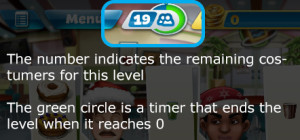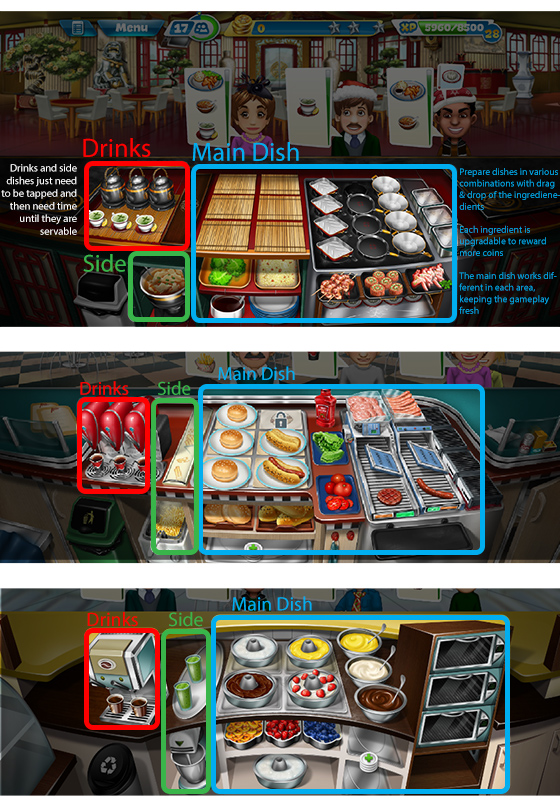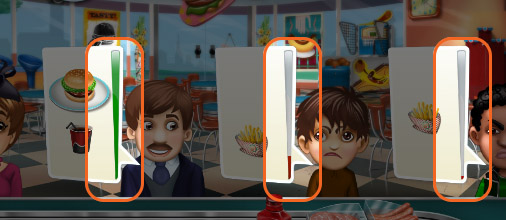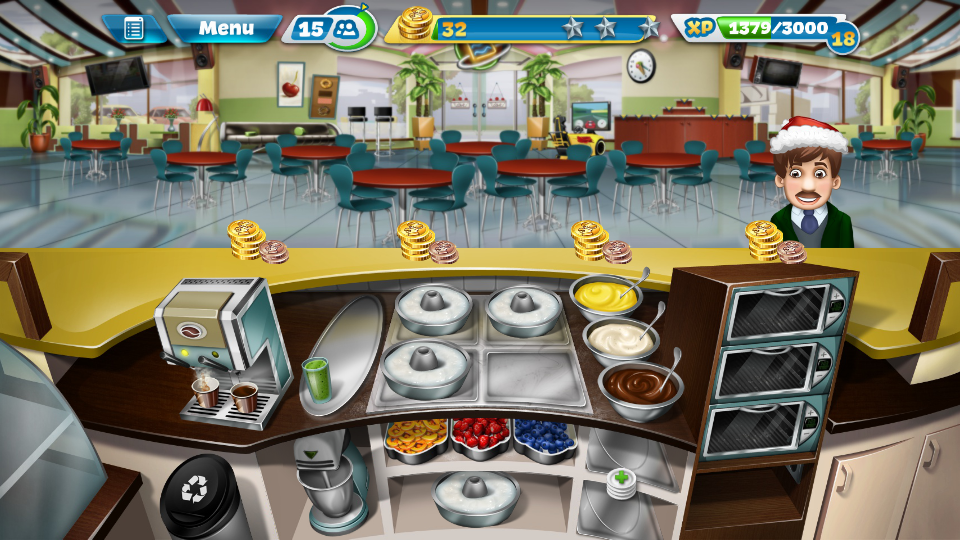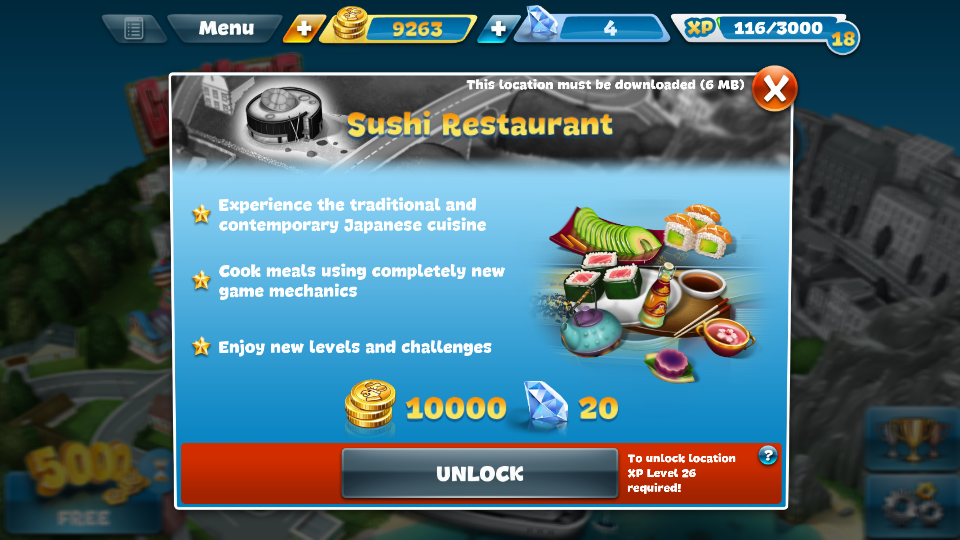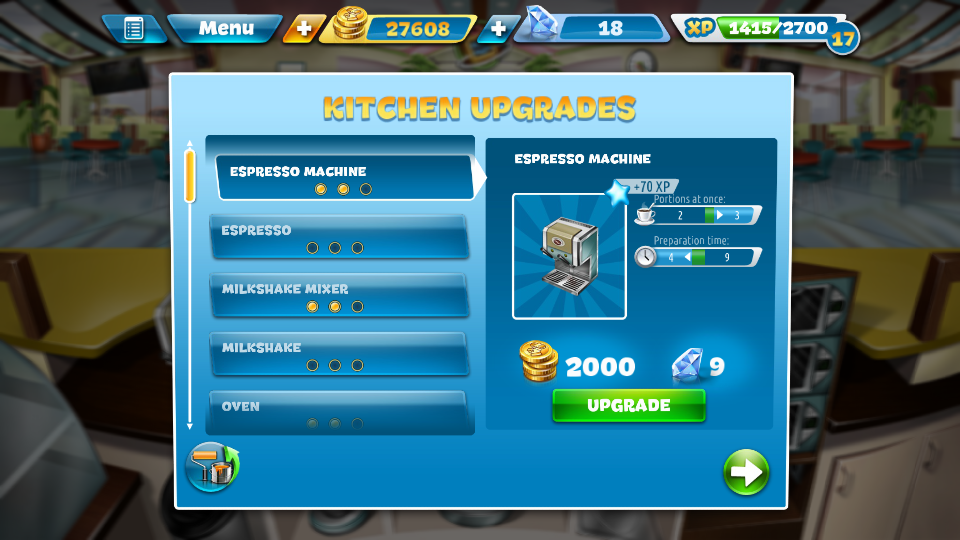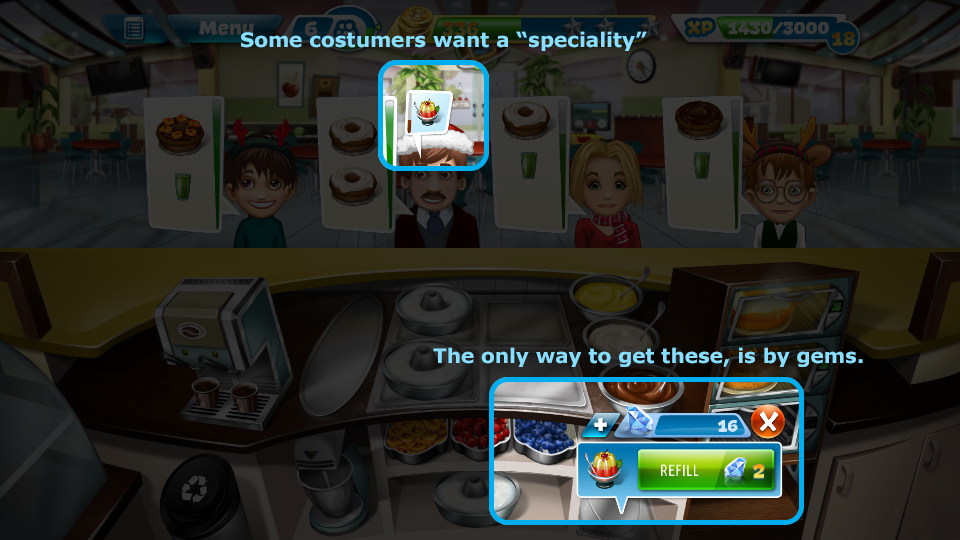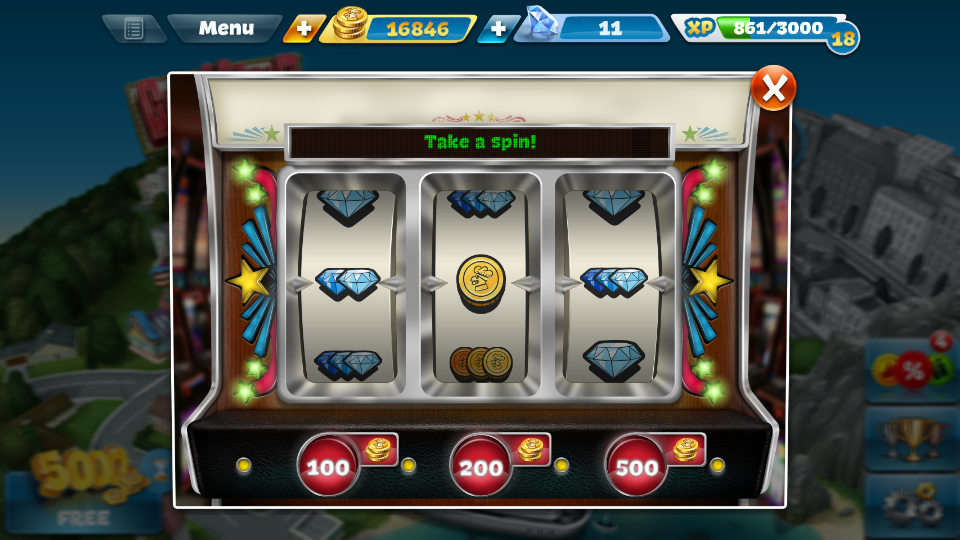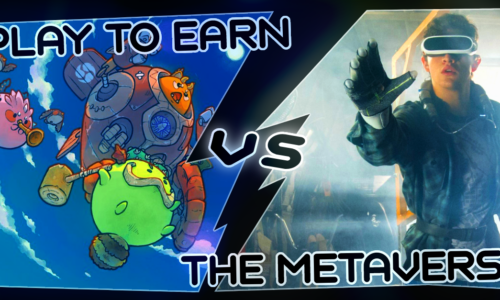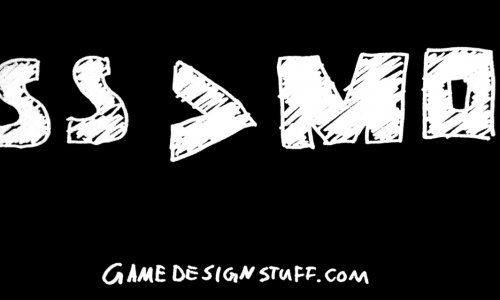“Cooking Fever” is a currently very successful casual game climbing the ranks in the respective App-Stores.
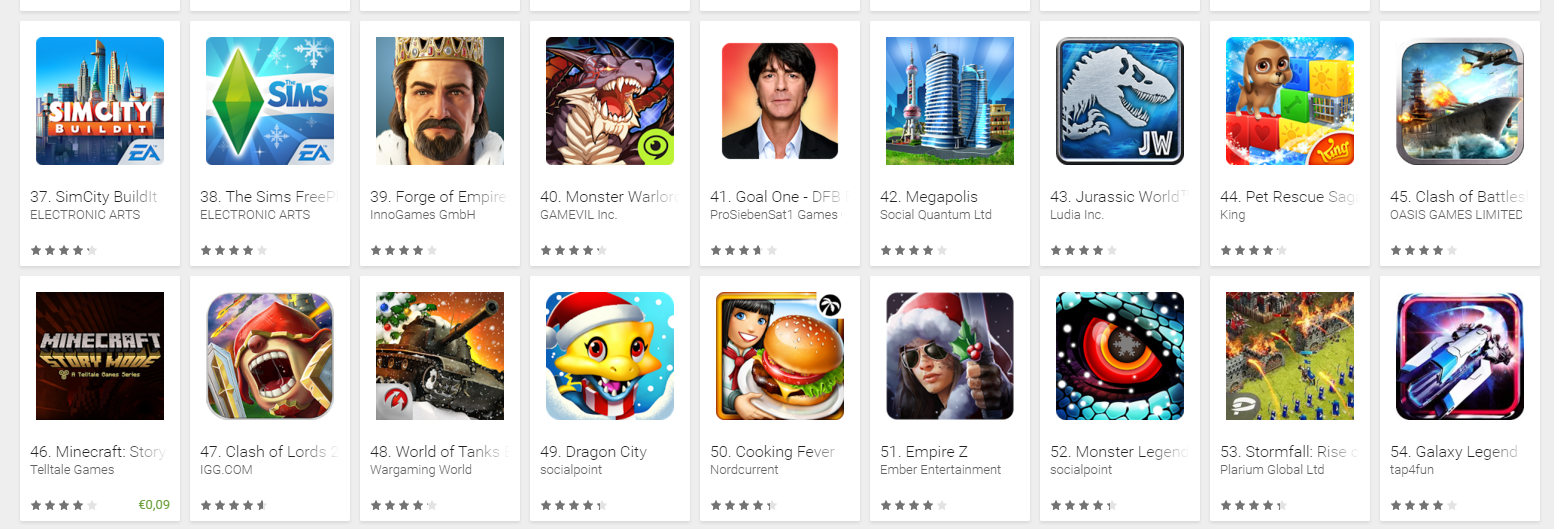
I argue that this success is stemming from its unique approach to casual games. The developers Northcurrent are targeting a currently untapped audience:
Casual players that like a challenge.
In this article, I will lay out what makes Cooking Fever so different from the other casual games in the market and highlight some of the game’s mechanics and systems that make it so unique.
TLDR;
- Cooking Fever emphasizes mastery and skill
- The gameplay is complex but not deep, disguised under an approachable theme, allowing players to experience casual but challenging gameplay
- No limits to gameplays enable player to practice and master levels
- Player need to upgrade the kitchen to fully utilize their skills and reach the highest scores
- Robust core gameplay that is expandable and offers a high degree of variance to create interesting challenges
- Very Slowly ramping difficulty ensures that casual players remain in the flow channel
- Players get addicted to the core gameplay as there is no restriction to gameplays but then monetize when they want to play additional content
- The additional content is not just more of the same, it offers similar gameplay that feels fresh and challenging all along
- Play or Churn approach feels fair but merciless, players know what they pay for, but cannot get everything without paying.
A new Genre?
This could be the start of a new genre as there are not many (well executed) games that offer this experience.
The majority of currently successful games targeted at a casual audience are based on one of these approaches:
- Turn based & highly random games with a simple core mechanic (bubble shooters, tile swapping/matching games)
- Monetizing near misses and a “just one more round”-lives system
- Candy Crush, Pet Rescue Saga
- Build & Expand games with appointment mechanics at their core where players progress by frequently showing up to the game and manage their resources / production
- Monetizing through timers and an economy that is balanced to create shortcomings of specific resources, and convenience features (bigger inventory)
- “Sim City BuildIt”, “Hay Day”
Cooking fever is in neither of these categories and still appealing to a casual audience.
A complex and not deep core gameplay is hidden under a very approachable theme. It starts very simple is and instantly rewarding while players prepare the first meals and serve them to their customers. The mechanics of a level remain the same but the complexity ramps up over the course of the game, creating more challenge. This happens in very small steps from level to level, making sure players remain in the flow.
Cooking Fever players want
- See their skills progressing and test it against increasingly challenging levels
- To complete an area by to get a perfect score in each of the levels
- reach the next level to face a higher challenge
- see and experience the different types of areas
- “Complete” an area
What makes Cooking Fever Different?
No Lives/Energy System
There is no limitation to play a round. The player can play a level as often as they want. This is a very important factor for the next two points.
Focus on skill
There is no randomness involved at all! A given level is always the same in all regards
This enables players to practice and learn a level. A factor that is crucial for players to feel proud of their achievements. Especially in harder levels on the later stages that require many rounds of play in order to get the “perfect”-score.
Flow
Finally, the concept of flow link has its appearance on the stage of casual games. The original flow concept refers mostly to the moment to moment experience of an activity.
By giving players the ability to play as often as they want while ramping up the difficulty very slowly, “Cooking Fever” is the perfect example for a well implemented concept of “Flow”.
Gameplay
Game-Loop
Playing a Round
A round ends when the time runs out, or after the last customer has been served. Players earn a score depending on the type of order and the time that they need to serve it.
Competence
With each round players build competence in these 3 areas:
- This particular level
- Each level unravels in the same way, being able to predict the orders will become vital to mastering a level
- This area
- Every level has a specific main dish, finding ways how to handle the orders in an area will help players receiving a higher score
- The general game
- Some of the mechanics are available in every level, playing any level will let players learn and practice their strategies
Letting players build and test their skills is crucial for “Cooking Fever”.
Level Structure
The levels are grouped into different areas, each area consists of 40 levels. To gain access to a level, players need to finish the previous level with at least 1 star. The star rating of a level depends on the score (coins) earned in that level. Players keep the score as a currency in a game.
Mechanics
Orders & Recipes
Players need to serve what customers want. Each level area has a unique theme and a different way of assembling the main dish.
Via drag and drop of the ingredients players prepare the meals that the customers demand for.
Each level has a certain number of customers, and each customer has a certain list of items that they want.
Besides the main dish, each area has side dishes / drink that are themed differently but always work the same.
Tips & Satisfaction
A happiness meter indicates the patience of a customer. After a customer becomes servable, the happiness starts to decrease. If it reaches 0, the customer will leave.
Happy customers leave a tip: the happier a customer is when he has been served all of the required items, the more tip they will give.
This is why it is crucial for the level to always have the same order of customers.
It gives players the ability to learn and master each level. At later stages of the game each point of score is very valuable and players gain the full control of the score that they reach.
Collecting Coins
After costumers have been served, they leave the value of the items + the tip on the counter. The number of customers that can be active at a given time is capped at 4. Collecting the payment, frees the slot. This mechanic gives players a control of the pacing of a level. Only after picking up the payment of a customer, will free the slot for the next one. At the same time, players are under pressure because of the global time limit for the level so taking too much time, might not leave enough time to deal with every customer: An interesting mechanic for an adaptive difficulty.
This gives players the opportunity to adjust the speed of the level and not overwhelm them. Each level is carefully paced. The developers have full control of how every level “feels” at a given time by balancing the customers’ requirements. Sometimes using more complex recipes, sometimes more simple ones.
Content
The mechanics allow a high variance to create a high number of levels per area that all feel different and allow for a shallow slope for the difficulty.
The food-preparation mechanics stay the say within one area. The way the design allows for a growing challenge in each level is by adding more components to the respective main dish.
Also, the kitchen appliances can be upgraded to not only serve 1 item per production cycle but 2 or 3. By adding more variance to the recipe – each level is challenging in its own way and must be practiced over and over in order to reach the highest possible score.
Currencies
Coins
Coins are earned in levels by serving customers what they ask for. The higher the kitchen upgrades are, the more users will score in a level. The score equals to coins.
Gems
The hard currency which can be obtained by an in-App-purchase or after leveling up (xp is earned by finishing a level). There is also a slot machine where players can invest coins for a small shot a gem reward.
Upgrades
Kitchen appliances and the restaurant can be upgraded permanently. Each upgrade either increases the value of a certain item, this will directly increase a players score. Or it is a “convenience” upgrade.
Some upgrades can be purchased with coins, which can be earned by simply playing levels, other upgrades require Gems. The levels of upgrades are unlocked by level within an area.
The convenience upgrades are the most beneficial upgrades from a player’s perspective as these directly impact the players’ capability to deal with the customers requirements.
It is very rewarding to unlock additional main-dish-slots as it is not automatically making the game easier – in fact, by adding slots, the game becomes more complex because players need to juggle more game-entities at the same time. Players can clearly see how they are becoming better at the game. Being able to manage more and more elements at once. Each level adds a small bit of challenge, making sure that no level-difficulty-jump is too steep to overcome. Upgrades are at the very heart of the games progression and monetization system. They are perfectly tied in to the core experience. Each upgrade can be recognized in the kitchen level immediately due to a dedicated asset.
Because each level is balanced so tightly, the impact of every upgrade can be felt immediately.
Score Balancing
The scores (coins) players can achieve in a level depend on the upgrades and the execution. Even with a nearly perfect execution, the score is capped by the upgrades.
A crucial point for the monetization is the fact that the star-Requirements for the levels are balanced so that it will be impossible to reach 3-stars in every level with coin-only-upgrades. This ultimately means, players need to pay if they want to reach the highest scores possible. But they are also motivated to get the level-execution perfect first.
Monetization
Having unlimited playable content only limited by player skill and upgrades, leaves the developers not much of a choice on where to monetize without harming the challenging core of their game. Players in Cooking Fever always know what they will get for their money. This makes the game very transparent for players and they will never feel cheated.
Any purchase the players make (except the cakes), increases the players’ capabilities permanently.
New Content
After playing so many rounds of the addicting core gameplay, the need for additional content is high. Gaining access to a new area costs a significant amount of hard currency. I expect the new content is one of the main conversion drivers.
Upgrades
As mentioned before, some upgrades require Gems. And some of them are obligatory to reach a 3-star-rating in some of the levels. Score wise, the 1-star-rating can be achieved with the coin upgrades – but it just doesn’t feel as great. It is always a struggle to finish all the costumers’ orders in time, even with perfect execution.
Theoretically, upgrades are only mandatory for the completionists who want a 3-star-rating in all of the levels, since every level is unlocked with just one star in the previous level. But players want to beat a level (3 stars) and what they need, are upgrades.
Some upgrades feel a bit “forced” upon the players. The customers in some levels ask for many items of a specific kind. Those items will create a bottleneck in the flow of the level. But a kitchen upgrade to relieve the players of that pain is just one purchase away. These are the times where the monetization is very obvious and players learn that this is no “free lunch”. Hence, it is a “churn-or-play” point.
Speciality
The consumable – since every free to play game needs a consumable, right?
Every area has a specific consumable that some customers ask for. It is only obtainable with gems though. Players can give them to customers which increase their tip.
Given that the games addresses skill & mastery driven players, I do not expect that this monetizes too well. It goes against the nature of the audience that the game is targeting as this would be almost like cheating.
Free Hard Currency
Players can earn 6 Gems every 5 levels. As usual, the XP progression is balanced in a way that level-ups happen more frequent at lower levels. That way, players can earn some hard currency early and can decide where to spend it. On the other hand, the rate of earning Gems dramatically slows down, leaving players no way to play the content at all.
Spinning Mechanic
Another very ineffective way to earn Hard Currency is the slot machine. The chances for gems are ridiculously low, though. They have to be – because coins can be grinded freely. If the chance of the slot machine for gems would be too high, the player could just grind for all the Gems that they need. Which is a great incentive to play even more, but eventually not leaving anything to monetize for the developers.
Conclusion
Fun core gameplay that is built on mastery and skill rather than randomness. Creating a different kind of fun compared many other casual games. The developers have a core mechanic at their hand that seems to have no limits to build more content for it, keeping their most engaged players in line. Unlike other games, there is hardly a way where players can get everything the game has to offer without paying. The monetization is transparent, but also merciless. Either players buy gems to unlock new content and gain the possibility to earn the highest scores, or they will stop playing. On the other hand, this a very fair way to monetize as players know exactly what they are buying. An overall very refreshing approach to monetizing a casual free to play game.




